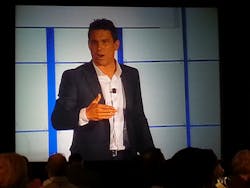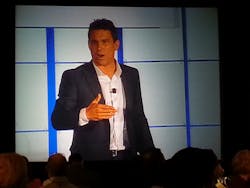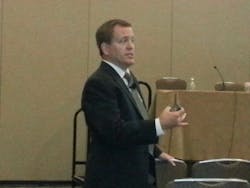Logistics Pros are Scaling E-Walls to Solve Real Problems
While it’s easy, it’s inefficient, takes longer and leads to a game of pong that goes nowhere. 55% of communication is body language. For the verbal part, don’t dive into business when establishing a business relationship, Helder suggested. There’s value in small talk. It builds trust. Think FORD when structuring your conversation—family, occupation, recreation then go deep into what you need to address.
The best politicians use this technique to build alliances and get what they want. It’s part of networking, and networking is something logistics professionals need to master, both on the distribution side and the people side. It’s a multidimensional skill that will help get your business through tough times. In his presentation on “Supply Chain 2030,” John Bell, assistant professor of supply chain management at the University of Tennessee Knoxville said doing business in other countries requires the building of partnerships.This is being addressed in a new Ph.D. research program at his school, looking into how logistics networks will serve growing urban environments. It’s all about partnerships.
“If you want to run a 40 ft. tractor trailer in downtown Paris you’ll need to partner with security and touch bases with a lot of competing interests,” he said. “Supply chain partnerships become a lot more important. You have to think about social and political implications. Connect with localized talent and production.”
This is especially important when faced with constraints such as material shortages. If your product has materials that are getting harder to source, contingency planning is vital. It might come down to creating databases of needed materials that are becoming more scarce and sharing that with your product designers so they can factor that in and come up with alternatives. To prepare for 2030, get used to designing products in a world of scarcity. Bell cited Toyota Motor Company as an example.
“Toyota has been down in South America the last couple years negotiating with countries like Bolivia to make sure they have access to lithium,” Bell explained. “They’re convinced that’s the motive technology for hybrid cars.”
Corporate citizenship is another competitive tool for companies of the future. Building schools will be just as important as building factories, Bell said.
“I sat down with the CEO of a major food manufacturer that buys a lot of vanilla from around the world,” Bell explained. “He’s around the world building schools to build strategic relationships with customers and suppliers to keep the supply chain working day to day. He deals with scarcity every day. Making those connections can give you access to scarce materials.”
The process of moving those materials through supply chains must also be rethought, said Benoit Montreuil, professor at the Université Laval. His proposal is that logistics professionals start thinking about scaling their e-walls into the physical internet of things. Just as Bell and Helder discussed ways to make connections in the real world, Montreuil put physical distribution in the context of moving product as efficiently as the Internet moves messages. Instead of moving data in standard bytes he talked about moving product in standard containers through open and shared transportation networks.“Don’t think about YOUR distribution network,” he suggested. “A network is what you exploit to deploy distribution. You don’t own the assets. Currently companies are integrated through EDI and JIT, but the result is centralized DCs and factories. This is asset intensive. The physical internet is about joining forces with five others shippers for economy of scale. It goes beyond collaborative logistics to connected logistics. You don’t care who you share the subway with and you don’t sign an alliance with the subway system to get around. Stop dealing with goods directly. Deal only with modular containers. Smart, traceable and routable—from the factory to retail shelves.”
Rolling your eyes yet? Go ahead, but this model is starting to take shape in other countries. In France road and rail transport is integrated into a physical internet backbone. As a result they’ve reduced manufacturing costs by 30% and greenhouse gases by 60% using existing infrastructures, facilities and demand patterns. Pilots are going on in Canada and China now has its first physical internet research lab. These are collaborations between government and academia.
Getting corporate buy-in is the big challenge. Montreuil said FedEx loves the concept. In fact they want to own it—which takes it out of the original concept of the utility model.
Montreuil envisions government incentive programs that would encourage logistics people to adopt this so products can be moved closer to cities.
“In Europe hundreds of millions of euros will flow into logistics,” he predicted. “The vision for 2030-2050 is to establish the physical internet in Europe.”
If all this talk about government partnership makes you a bit queasy, let’s bring the partnership concept back into the private sector. Dick’s Sporting Goods is partnering with vendors to improve how products are shipped through its networks. Marty Hahn, manager of vendor relations at Dick’s, described how his organization is improving relationships with vendors by moving away from problems like chargebacks and compliance issues and is now working with vendors on flow of goods, faster turns and better profits.Dick’s worked with Kurt Salmon Associates and learned how to get beyond label placement and address bigger issues like getting freight to the right place at the right time. In the process Dick’s transferred responsibility for the documentation of compliance out of their corporate office and down to each DC. This gets information to the people at Dick’s who need to see it a week faster and also gets information to the right person at the vendor so they can solve problems quicker.
“Originally the DC would write a compliance issue up on paper and take a photo but they wouldn’t make a connection to what the issue was,” Hahn explained. “When we gave them the opportunity to key it into the system and validate it, that gave them more ownership. And if we have a better understanding of what the issue is we can explain it better to the vendor. We’ve become more consistent. That has helped us right-size compliance. It’s not about dollars but the issue and how to fix the issue.”
Dick’s has moved from an average shipping window of 21 days down to 8 days. Compliance is no longer the priority. Making sure DCs get the right inventory is. That’s a matter of making the right connections with the right people in the right networks.
Coincidentally, that seems to be what’s happening at the WERC conference here in Chicago.
About the Author
Tom Andel Blog
former Editor-in-Chief
As editor-in-chief from 2010-2014, Tom Andel oversaw the strategic development of MH&L and MHLnews.com, bringing 30+ years of thought leadership and award winning coverage of supply chain, manufacturing logistics and material handling. Throughout his career he also served in various editorial capacities at other industry titles, including Transportation & Distribution, Material Handling Engineering, Material Handling Management (predecessors to MH&L), as well as Logistics Management and Modern Materials Handling. Andel is a three-time finalist in the Jesse H. Neal Business Journalism Awards, the most respected editorial award in B2B trade publishing, and a graduate of Cleveland’s Case Western Reserve University.




